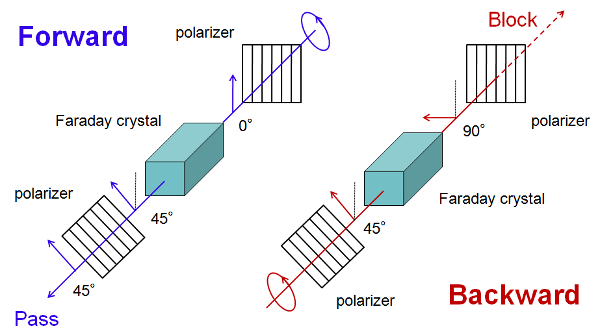Fiber optic isolator is a passive component used for fiber optic communications. As a magneto-optic device, the purpose of optical isolator is to allow light to be transmitted in only one direction. This helps prevent laser source from unwanted feedback which will damage the laser source or arouse unexpected laser problems, such as mode hop, amplitude modulate, frequency shift and so on. Therefore, isolator is an useful and indispensable device to reduce these effects. In the following parts, fiber optic isolator’s construction, operating principle and classifications will be discussed.

Construction of Optical Isolator
Fiber optic isolator includes three main parts of an input polarizer, a Faraday rotator with magnet, and an output polarizer. Only linearly polarized light can pass through the input polarizer into the Faraday rotator. The function of the Faraday rotator is to rotate the input light by a certain angle before it reaches the output polarizer. This allows the light in the forward direction to pass unimpeded. However, the light in the reverse direction will not be able to pass the optical isolator and is either reflected or absorbed. These three components of optical isolator skillfully work together and ensure the normal transmission of light signals.
Operation of Optical Isolator
The operation of optical isolator is based on the Faraday effect which was discovered by Michael Faraday in 1842. Faraday effect refers to a phenomenon that the plane of polarized light rotates while transmitting through glass (or other materials) that is exposed to a magnetic field. The rotation direction depends on the direction of the magnetic field instead of the direction of light transmission.
According to different light directions, there are two types of operation modes. One is the forward mode and the other is the backward mode. The forward mode enables light enter into the input polarizer and become linearly polarized. When laser light reaches the Faraday rotator, the Faraday rotator rod will rotate by 45° polarization. Thus, the light finally leaves the output polarizer at 45° polarization. However in the backward mode, the light first enters into the output polarizer with a 45° polarization. Next, as it passes through the Faraday rotator, it continues to be rotated for anther 45° in the same direction. Then the light of 90° polarization becomes vertical to the input polarizer and can not leave the isolator. As a result, the light will be either reflected or absorbed.

Types of Optical Isolator
1) Polarized Optical Isolator
Polarized optical isolator employs the polarization axis to keep light transmit in one direction. It allows light to propagate forward freely, but disallows any light to travel back. Also, there are dependent and independent polarized optical isolators. The latter is more complicated and often used in EDFA optical amplifier.
2) Composite Optical Isolator
Composite optical isolator is actually a type of independent polarized optical isolator. It is used in EDFA optical amplifier which consists of many other components, such as erbium-doped fiber, wavelength-division multiplexer, pumping diode laser and so on. Since there are many other components in EDFA module, this type of isolator is named as composite optical isolator.
3) Magnetic Optical Isolator
Magnetic optical isolator is essentially the polarized optical isolator in another expression. It stresses the magnetic part of a Faraday rotator. The Faraday rotator is generally a rod made of a magnetic crystal under strong magnetic field with Faraday effect.
Conclusion
In summary, fiber optic isolator guarantees the stable function of laser transmitter and amplifiers by eliminating unnecessary lights. It also ensures a higher performance of light transmission. Using fiber optic isolator is no doubt a good choice for your network.
没有评论:
发表评论